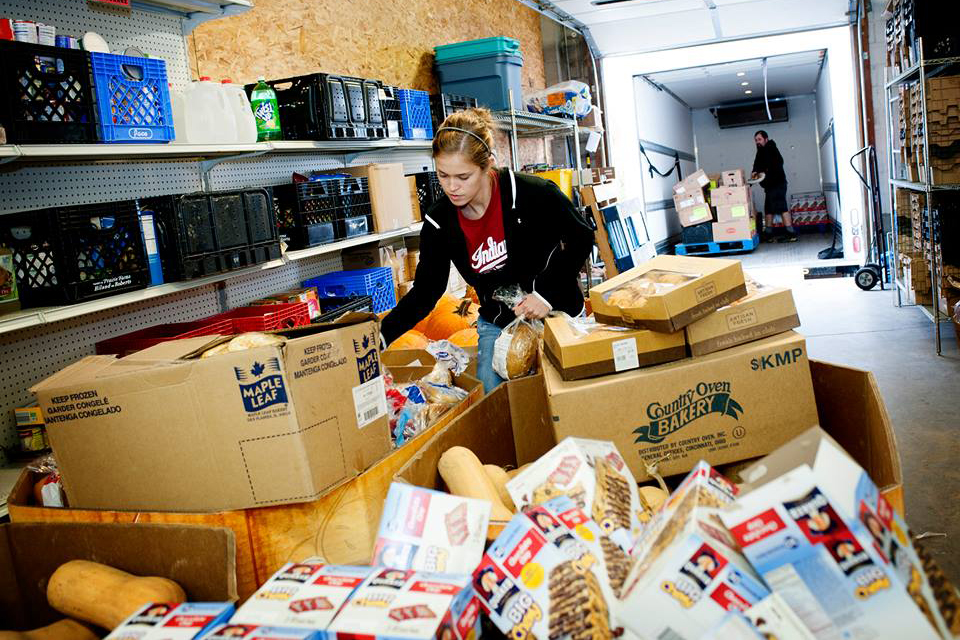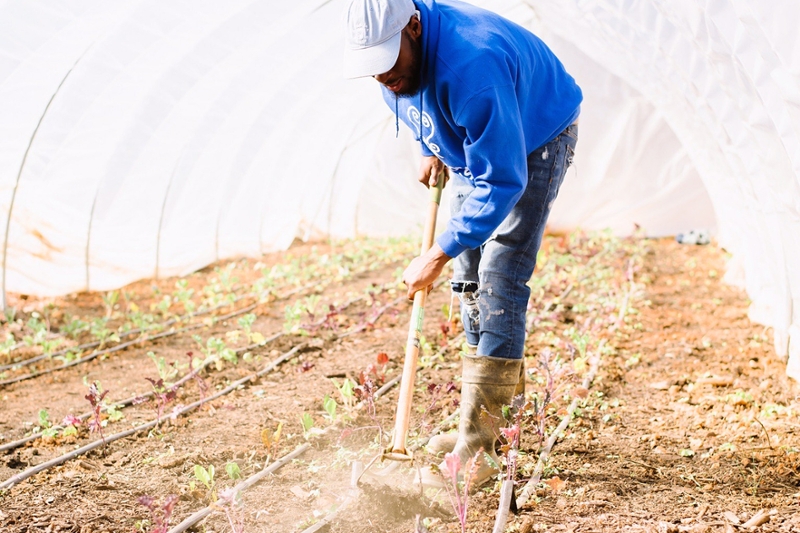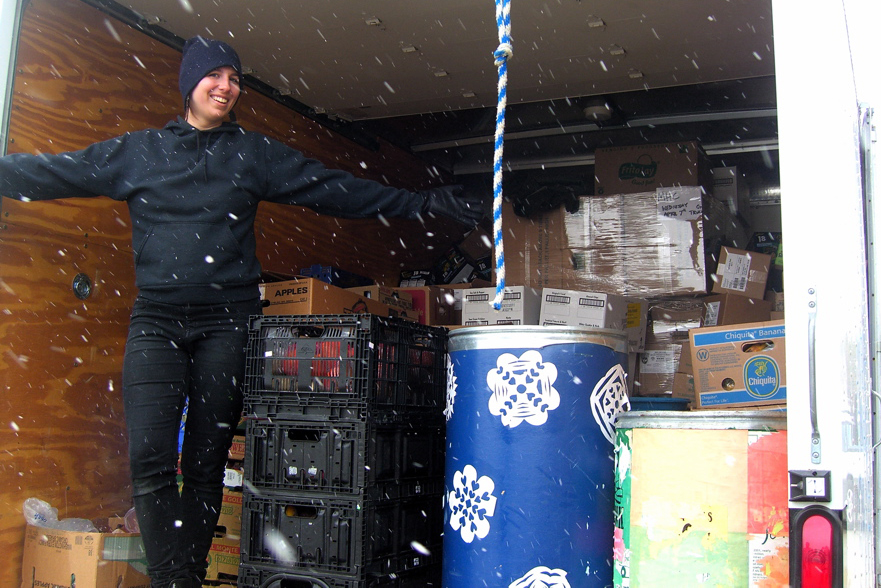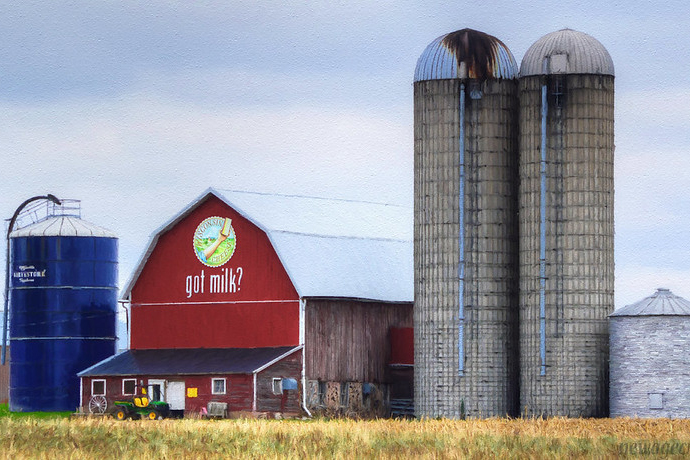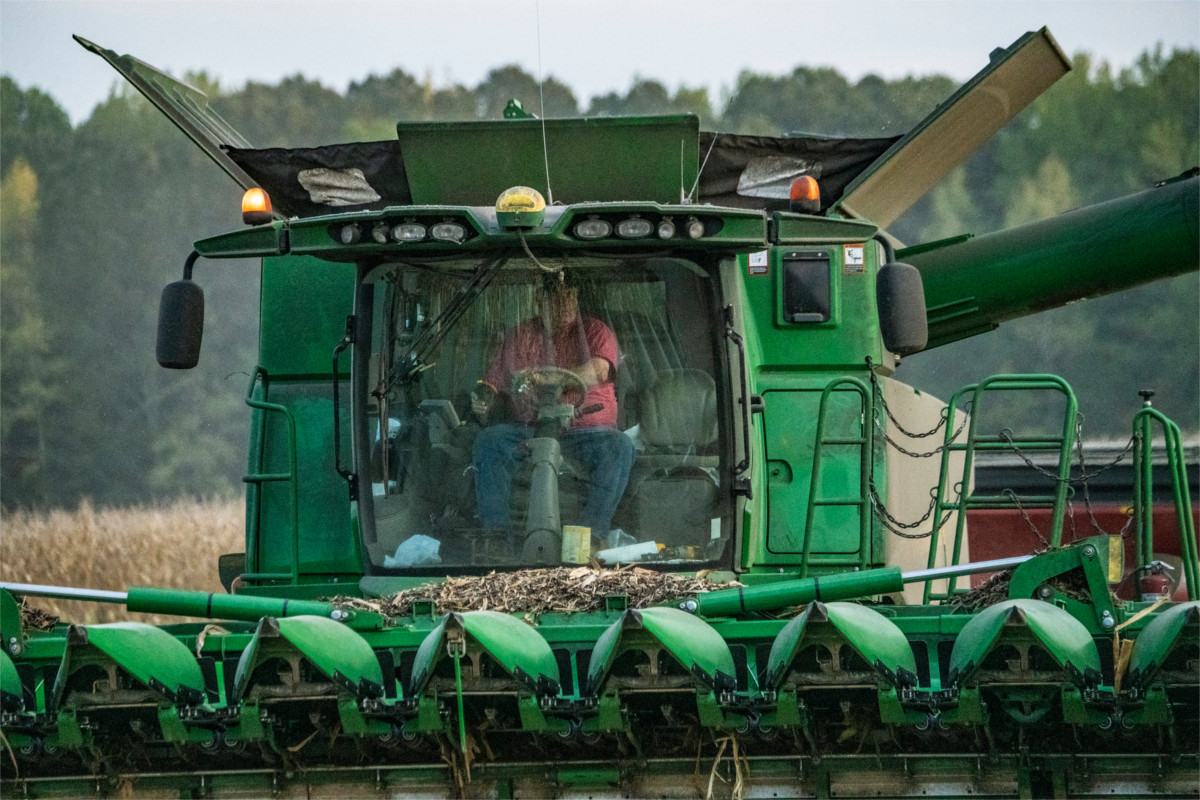(Earth Eats Theme Music)
KAYTE YOUNG: From WIFU in Bloomington Indiana, I’m Kate Young and this is Earth Eats. As the host of a food show with a growing emphasis on food justice, I’m always a bit conflicted when Thanksgiving rolls around, and I know I’m not the only one. Soleil Ho, ood critic for the San Francisco Chronicle wrote about it this week in her newsletter, Bite-Curious.
I love the tradition of gathering around a table of good food, and contemplating what we’re grateful for, but I can’t ignore our nation’s troubled history with the indigenous people of North America, and just cover that up with cheery recipes for sweet potatoes or cranberry sauce. So I don’t have any holiday recipes this time. But we’ll give thanks for orchards and nut groves, we’ll celebrate a farm in North Carolina that puts the African American experience front and center and we’ll revisit a complicated conversation with Amanda niki about holiday food drives. It's all coming up on earth eats, so do stay with us.
Hello Renee, what’s the news?
RENEE REED: Hi Kate, we’ve got some grim news about farming today. Nine Midwest states have declared emergencies due to shortages of propane, which farmers need to dry to soggy crops harvested late in the season. Spring flooding this year caused many farmers to plant later than usual, and that has pushed harvest season into the wetter months of fall. Farmers use propane and grain driers to reduce to moisture levels in grain crops before selling to markets or storing. Soggy grain takes more energy to dry. Early cold temperatures have overlapped with the drying season, causing a spike in demand for propane from homes and heated barns for livestock as propane-fueled grain-dryers kick into gear.
The shortage does not affect the whole country, but unexpected demand has caused transport delays as propane tankers line up to reach the Midwest from other parts of the country. Corn growing states depend on a network of pipelines, trains, and trucks to keep the pipeline flowing. On November 1st, the federal motor carrier safety administration declared a regional emergency for Illinois, Iowa, Kansas, Minnesota, Missouri, Nebraska, South Dakota, and Wisconsin. Several governors have declared their own states of emergency. The emergency declarations help companies to expand hours of service and lift load restrictions on delivery vehicles.
Midwestern farm communities are already grappling with rising bankruptcy rates, declining income, and flagging exports, due to the U.S. – China trade war. Wisconsin and the dairy industry have long been synonymous. But a stunning increase in dairy farm closures may soon change that. Trade wars, rock bottom milk prices, and increased cost in farm equipment have hit dairy farmers hard in the last few years. Though milk prices went up this year, for many the reprieve was too little, too late. In the past year, 48 Wisconsin dairy farmers filed for chapter 12 bankruptcy – the most in the country. The number of dairy farmers in the state has dropped nearly 50% in the past 15 years. Along with record farm closures, a record 915 suicides were reported in Wisconsin in 2017. While exact numbers of farmer suicides aren’t clear, many suspect the parallel increases are linked. A 2017 report from the center for disease control, said farmers are committing suicide at twice the rate of veterans.
I’m Renee Reed, and that’s our news. Thanks to Chad Bouchard and Taylor Killough for those stories.
KAYTE YOUNG: Thanks Renee.
RENEE REED: You’re welcome Kayte.
(Earth Eats news music)
KAYTE YOUNG: [narrating] Here in Bloomington Indiana, we’re lucky to have a community orchard. The Bloomington Community Orchard is an organization that maintains fruit-bearing trees on a plot of land next to a city park in Bloomington. The trees are planted and cared for by volunteers and the fruit is freely available to anyone.
The orchard is also involved in education programs, community plantings, and fruit tree giveaways. Last year they partnered with the city of Bloomington to plant a nut-tree grove on a piece of land between the YMCA and the Winslow little league baseball fields, just a stone’s throw away from the orchard’s main site. It’s a grassy gentle slope, just off of a jogging path, and in view of an upscale subdivision to the east. They planted the grove in stages, with the 3rd and final planting during Memorial Day weekend a couple of weeks ago. Earth Eats was on site for the first planting session on Earth Day in 2018. When I arrived, Ashley Thomas was mixing up some amendment packs for each tree.
ASHLEY THOMAS: Yeah, so we have a rock phosphate, we have pelletized gypsum, and green sand.
KAYTE YOUNG: [narrating] Ashley is the partner plantings manager for the community orchard, and she’s organizing this planting event with a group of volunteers. The volunteers have been digging holes for the trees as instructed, and Ashley is now demonstrating how to get the trees planted.
ASHLEY THOMAS: You notice its much wider than the tree itself, and like I was saying earlier, we wanna perforate the sides so that the roots will also spread out. We also have these amendments already bagged out…
KAYTE YOUNG: [narrating] And then it’s time to pull the tree from the pot, and set it in the hole.
ASHLEY THOMAS: and just kind of gently loosen it. You don’t want to tug too hard on it, so I kind of massage and like squeeze on the sides here until it loosens up. A good way to measure how deep you want it is taking this level to the ground. That you can see the soil line is way lower than we want it to be.
KAYTE YOUNG: [narrating] With the new trees sitting in the middle of the hole, Ashely lays a shovel handle across the hole, to show where the soil line will be once the hole is filled in. You don’t want the soil to go above the line where it already has been, when the tree was in the pot.
ASHLEY THOMAS: So we got the right depth, take the tree back out and we’re gonna spread these amendments all… all into the hole here. That way it really helps facilitate that root growth, nutrient intake, all of that. So we got it in the right depth, we’re just gonna fill it in with soil in here. It’s a good idea to be filling it with water as you’re filling it with soil.
That’s great thank you.
Do a little bit more water… so i just kinda add a little bit… add a little bit more soil… and you do wanna be generous with the water when you first plant it. It really is gonna help set it up, get it situated into the spot, and gently tamp it…
KAYTE YOUNG: [narrating] Next Ashley dresses the top of the soil with a layer of compost, then its time for mulch. The volunteers mulch each tree with wood chips piled near the path.
ASHLEY THOMAS: But you wanna make sure its not right up against the tree, at least 6 inches out away from the base of the tree. And we do pretty wide, kind of like a donut and you wanna do about 4 to 6 inches tall, so it’s a pretty good amount of mulch per tree. But you wanna make sure theres a good distance between the mulch ring and the base of the tree itself. Its gonna keep a lot of this grass from growing back in it, but its also gonna help retain some of the water in the soil.
Does anybody have any questions?
KAYTE YOUNG: [narrating] Planting fruit trees always strikes me as a hopeful act. It’s looking to the future, not like when you plant something like zucchini or carrots. I mean you have to wait a bit for the carrots to grow, but you’ll harvest them that season. With a cherry tree, its gonna be a while before you’re making cherry pie… years. And with nut trees, its an even longer wait.
I spoke with Dani Ansaldo, who’s been working with the Orchard for years, and I asked her how long it would be before these trees would be producing.
DANI ANSALDO: You know its gonna be a few years… yeah. My hazelnut bushes, I think I started being able to gather the hazelnuts between 7 and 9 years, I can’t remember exactly.
KAYTE YOUNG: Why do you think it’s important to plant trees like this that you’re not really… maybe you won’t be someone whose harvesting from them.
DANI ANSALDO: That’s true. Yeah, we have a couple of those in the orchard too. The Korean pines in the orchard, they’re probably gonna be… we’ll be able to harvest from them in like 50 years, so that’s quite a few generations from now that will get to benefit from them. But I really think its important for us to plant trees and just let our kids and our grandkids eat from them. And learn from them, and you know they also just will offer a lot to the environment just with having something to soak up extra water, help with erosion, and take up space where grass was gonna grow so we don’t have to mow as much.
KAYTE YOUNG: [narrating]I asked another community orchard volunteer Josh David, how long he thought it would take for the trees to bear fruit, or in this case nuts.
JOSH DAVID: You know I think… and what I know… and uh, still learning, is that the nut trees take a little longer than fruit trees typically. I think fruit trees you can expect them to produce their first harvest in the first five years or so, whereas I think nut trees take maybe 7 to 10, sometimes even longer if they’re a standard size tree. Right? So dwarf trees and semi-dwarfs as just smaller trees overall will just start producing sooner than standard trees. Whereas most nut trees, especially these that we’re planning today are standard size so they’ll be bigger, so they may take a little bit longer.
KAYTE YOUNG:Why would you wanna come out here and plant trees that you may not even be able to harvest from?
JOSH DAVID:The idea is that once they’re in and they’re producing, they’ll be producing for 50-70 years. So yeah, the trees we’re planting today, we may never meet the people that’ll eat them but they’ll certainly, hopefully,think back fondly on the people that came out here and sweated and got their hands in the soil today to make sure the community had a few more, you know, free access to local food. Its good for the community, its good for all of us, you know so…, the more people that know what they can grow around here. Right? I think today we’re planting hazelnuts, and walnuts, and pecans, and almonds, and so… just you know, most people don’t even necessarily think about those as things you can plant here. Right? So part of its just you know, just appreciate what can be done, and what they can even do in their own yards, and lives. Part of it is just appreciating the local government here wants to, you know… use public land to give back to the community, educationally and in terms of the harvest. So we’re just happy and honored to be a part of that.
KAYTE YOUNG: [narrating] The act of planting trees is hopeful, and forward-thinking for some of the volunteers. But I asked 4 year old volunteer Zahir, what he was looking forward to… and it wasn’t the harvest that might be 7 to 10 years away.
ZAHIR: I want to… I just want to go home and eat some noodles but my stomach is growling.
KAYTE YOUNG: [narrating] Some needs are just more pressing than others. Come to think of it, noodles sound pretty good right about now. Find out more about the Bloomington Community Orchard and how you can get involved on our website EarthEats.org.
-Music-
KAYTE YOUNG: Production support comes from Bill Brown at Griffy Creek Studio, architectural design and consulting for residential, commercial, and community projects. Sustainable, energy positive and resilient design for a rapidly changing world. Bill at griffcreek.studio.
Elizabeth Ruh, enrolled agent with personal financial services. Assisting individuals and businesses with tax preparation and planning for over 15 years. More at PersonalFinancialServices.net
And insurance agent Dan Williamson of Bill Recsh insurance, offering comprehensive auto, business and home coverage in affiliation with Pekin insurance. Beyond the expected. More, at 812-336-6838.
(Music)
KAYTE YOUNG: [narrating] Between merging two bee colonies and stopping by the tractor supply store, farmer, educator and activist Kamal Bell took the time to sit down with Josiphene McRobbie and to talk about the story behind San Kofa Farms ?
JOSEPHINE MCROBBIE: (narrating) A nature lover and animal fanatic since childhood, Kamal Bell eventually went to college to become a veterinarian.
KAMAL BELL: My dad has like a book collection that can rival like anything in my mind. And one of the books that he always suggested I read was A Message to the Black Man in America by Elijah Mohammed. And what I learned in that book was that…, and I had to question myself is, like… what am I doing for black people? And that was when I was like “you know, I’m gonna become a farmer”
JOSEPHINE MCROBBIE: (narrating) Kamal ended up switching his major to animal sciences and industry. He worked on North Carolina’s campus farm, got his master’s degree, and started teaching middle school. He also began envisioning a place where he could grow food to combat food insecurity in black communities.
Kamal is now the CEO of SanKofa farms and its associated teaching program in North Carolina. It was clear to him when starting the farm just how little some people knew about the history of black people and land ownership in the U.S.
KAMAL BELL: And that’s a part of our story that I don’t think people really understand. It’s like “Oh, did you get you get your farm? Was it passed on in your family?” I’m like “No” and it kinda just stops.
I don’t think we realize how hard it is as a black man, especially to go through the USDA to acquire land to teach black students.
JOSEPHINE MCROBBIE: (narrating) In 2016 Kamal received a USDA direct farm ownership loan to start SanKofa farms on 12 acres of land. He secured additional funding to help the farm get set up with big ticket equipment, like observation beehives and a caterpillar tunnel for crops.
KAMAL BELL: Farming isn’t difficult, its getting the infrastructure to produce food, that’s the hang up in farming. So…, and well the land too. So the land and infrastructure. You need a well, you need equipment, you need all these different things and acquiring those things is very difficult. Once you get it, you can learn it and you can tweak your system that fits you. So it’s not a specific system that works for all farmers, its what works for you.
JOSEPHINE MCROBBIE: (narrating) The agricultural academy at SanKofa is a mentorship and skill building STEM program for African-American young men. Lessons are available everywhere at the academy.
KAMAL BELL: And anybody that has a farming background knows that you can’t do anything by yourself. Well, I mean you can but it takes a long time, and it takes a lot out of you. That’s the number one that gets to students. Like you’re not… you can’t be an individual on the farm. And we’ve had to slowly introduce that to the youth. Just because… like, if you go on the farm and you try to do something, and you’re not aware of people around you, you get hurt and you hurt other people. So that creates a sense of responsibility. That teamwork aspect does as well. So just being able to introduce a different activity to the students, you’ll get a leadership aspect, you’ll get a science…, well a STEM aspect, you’ll tie in all these different aspects because agriculture does that by… just by how it functions.
JOSEPHINE MCROBBIE: (narrating) The farm focuses on vegetable crops and beekeeping.
KAMAL BELL: So we have 15 beehives, and along with myself, 4 other students are all certified beekeepers. The youngest certified beekeeper being 12.
JOSEPHINE MCROBBIE: (narrating) There’s a reason Kamal thinks bees are so approachable, even though they might worry the kids at first.
KAMAL BELL: Everybody has interacted with a bee at some point in their life. So it’s really familiar, whether you’ve been stung by one, got a stinger or you’ve been chased by one, you’ve seen them in nature, in the city, anywhere. I think that’s just something that people take to very, very well. So I think its just more familiar than like a pig or a chicken. Like you might see those on TV. But actually being able to interact with honeybees, its something that a lot of people have done over their traditional lifestyle. So that’s something that they really take onto, like “but its really cool. I might work with some bees” So just seeing students get over their initial fear of working with animals and livestock is really cool.
JOSEPHINE MCROBBIE: (narrating) In addition to teaching farming, the SanKofa academy runs an AirBnb agritourism program called Bees in the Trap. And Kamal encourages students to participate in public speaking engagements. He says these additional experiences help students prepare for careers in industries like agriculture that are undergoing major shifts.
KAMAL BELL: I want them not to think about agriculture as just being a farmer, because that doesn’t exist anymore. Just doing one thing doesn’t exist in any industry.
JOSEPHINE MCROBBIE: (narrating) Sankofa farms and the Duke World Food Policy Center were recently awarded a major service learning grant from the USDA. The grant team will develop a curriculum for 5th grade students that aims to improve health outcomes through learing about food traditions and agriculture.
KAMAL BELL: So we really just want more so capture the journey and tell the story of African Americans and people of African descent and our contribution to agriculture in the grand scheme, and then also to focus and narrow it down to the south here in the United States.
JOSEPHINE MCROBBIE: (narrating) Camal hopes that the hidden histories of new tradition of black culture will yield surprises for students and make them feel connected to what they eat and how it fuels their bodies.
KAMAL BELL: And the more you look into the whole soul food aspect and the food traditions, you see they are more so vegan than anything else. Like, that was really interesting to me.
JOSEPHINE MCROBBIE: (narrating) Working with animals and land means a lot to Camal and it ends up meaning a lot to the students as well.
KAMAL BELL: It seems like we introduce animals to students and they figure out that they can work with them. It just opens up a whole vast amount of opportunities for them. Just because they usually don’t have… the like, urban youth usually don’t have the opportunities that other students would have. Like especially African American boys, so just being able to bring things to them front and center is something that allows their minds to start working where they can see themselves “Like you know, I can work with plants, I can work with animals, I can work with bees. I can see myself building things, I can see myself being an engineer” It just really brings them into… like really just, they have a place. It really just helps them identiy a place.
JOSEPHINE MCROBBIE: (narrating) The farm will soon be solidifying its place in a new way. Camal’s brother is currently working on a children’s book, its titled “Kalil’s Day at SanKofa” named after Camal’s oldest son.
KAMAL BELL: It reiterates a lot of things too, its about…like, just positive imagery of black people in agriculture. Because you don’t see that at all, espicailly from a kid’s perspective. Like we might probably be the first black farmers with a black children’s book, around farming.
-Music-
KAYTE YOUNG: Thanks to producer Josephine McRobbie for that story.
KAYTE YOUNG: [narrating] This time of year in communities across the country, schools and business will be collecting cans for food drives. It's an American tradition during the holidays to balance feast planning and shopping trips with plans to help others. And to share good fortune with those experiencing hard times. In recent years though, I’ve come across criticism of the food drive approach as an inefficient method for getting food to people experiencing food insecurity. All those cans and boxes need to be checked and sorted. Plus agencies can obtain more food for less money through the food banking system. So individuals paying retail prices for food is a waste of money. It’s better, the argument goes, to give money directly to trusted organizations.
Amanda Nickey is the president and CEO of Mother Hubbard’s Cupboard, a community food resource center in Bloomington, Indiana. The Hub, as its referred to locally, offers food assistance through a food pantry, garden and nutrition education programs plus an advocacy program addressing root causes of hunger and offering policy education and civic engagement opportunities for Hub community members. I sat down with Amanda Nickey for her thoughts on holiday food drives.
KAYTE YOUNG: When people do feel inspired to run a food drive, either at their place of business or at a school, just gathering up those canned goods and non perishables and bringing them into the food bank or the food pantry. Is this the best approach if people really wanna have an impact?
AMANDA NICKEY: I think it depends. If there’s intention on the kinds of foods you’re collecting. So there’s kinda this deeper level of change that can happen if you take your kids out to the grocery store and you say “we’re gonna spend 25 dollars on food for other people, and I want to think about things that other people might like, and keep in mind the kind of things that you like, because other people are like you” I think there’s a really good lesson there to be learned. And that has an impact on you, it has an impact on your children, it has an impact on the people they might talk about that experience with. It’ll have an impact on their children when they remember that experience and wanna recreate that for their own kids. It might make them think about people who are different, or people who have less than they do. In a way that’s more humanizing. So I think that yes, food drives have their place, but if we’re talking in terms of just efficiency, youknow, for a pantry of our size that’s serving you know thousands of people a week, a handful of cans is… you know, kinda a drop in the bucket in terms of the amount of food that we’re putting out. And because of our relationship with our local food bank, we’re able to you know, leverage a dollar to get many more pounds of food than one individual may be able to do at the grocery store. So there are ways to look at that. Question, a couple of ways to answer that question and it kind of really depends on what you’re goal is.
KAYTE YOUNG: [narrating]: I asked Amanda, let’s say the goal is to get the most bang for your buck. Is it better to give money to organizations like hers to purchase food through the food bank, or should people buy food at the grocery store and donate it to a food drive?
AMANDA NICKEY: I’ll clarify that we don’t purchase the food from the food bank. We are able to get more food for a dollar than most people are. We pay a shared maintenance charge to the food bank for certain items that are in their warehouse. And a lot of the fresh food and healthier foods we actually get for free. And so people can also think about in terms of supporting organizations like Mother Hubbard’s Cupboard, or other organizations in town that are providing emergency food services, think beyond just the food. Think about the food that are putting it on the shelves, the people that are sorting it, the people that are preparing it in the kitchens, the staff time that goes into doing all of that work, the rent or mortgage payments we might have for those facilities, the utilities, you know we have to have heat, we have to have electricity, that those are expenses that are just as important for people to think about and to support. That just the food items alone, they don’t happen on their own. If you give us a can of green beans, or a can of tomatoes, its not making it out on that shelf by itself. There’s a lot things that have to happen behind the scenes for the programs to run.
KAYTE YOUNG: [narrating] we talked about the importance of retaining skilled staff to carry out the programming. And nicki said she didn’t want her employees to need to use the food pantry services they provide.
AMANDA NICKEY: As the leader of the organization its important to me that our staff is adequately compensated, so fair wages are something that we strive for. And it’s part of our strategic plan, we want employees to feel supported and taken care of. There’s a difference between being… providing efficient services and being fair to our employees and providing efficient services kind of the backs of our employees.
KAYTE YOUNG: [narrating] Amanda talked about how efficiency isn’t the only thing to consider when it comes to holiday giving.
AMANDA NICKEY: We have models for those that are interested in running a food drive for us. And some of what we talk about is just the joy that can be found in a special food. Just some kind of treat, that when you are really making decisions about whether you can afford food or gas this week, that might do more than just kidna of feed you, feed your body. Having access to something that’s special or a treat might really… just help you mentally. Help you get through the day. I like chocolate, it helps me get through the day. And so being able to have food that can be joyful is really important.
KAYTE YOUNG: yeah I think some of the criticism that I’ve seen around food drives “Oh, so you’re just emptying out your cupboard of things you know you’re never going to eat” Can of green beans that’s been stuck at the back of the cupboard gathering dust. And what you’re suggesting is just “why don’t you actually think about the people that are receiving it, not just what your extra thing is that you’re not gonna use”.
AMANDA NICKEY: Right. And use it as… use it as a opportunity or a practice to think about others for that time. And not necessarily about how it makes you feel or clearing up the space in your cabinets or whatever, or feeling better about the food that you didn’t’ eat and now it’s not gonna go to waste. Be intentional and think about the recipients.
KAYTE YOUNG: [narrating] That was Amanda Nicki of Mother Hubbards Cupboard, community food resource center in Bloomington, Indiana. You can find more from my conversation with Amanda, and her colleague Stephanie Solomon talking about the importance of challenging dominant narratives around hunger. Those conversations are linked on our website, EarthEats.org.
(Earth Eats Theme Music)
RENEE REED: The Earth Eats team includes Eobon Binder, Chad Buchard, Mark Chilla, Abraham Hill, Taiylor Killough, Josephine McRobbie, Daniel Orr, the IU Food Institute, Harvest Public Media, and me, Renee Reed.
Our music is composed by Aaron Toby and performed by Aaron and Matt Toby. Earth Eats is produced and edited by Kayte Young and our executive producer is John Bailey.
KAYTE YOUNG: Special thanks this week to Kamal Bell, Amanda Nickey, Ashley Thomas, Dani Ansaldo, Josh David, and Zahir.
Production support comes from agent Dan Williamson of Bill Resch Insurance, offering comprehensive auto, business and home coverage in affiliation with Pekin Insurance.
Beyond the expected, more at 812-336-6838
Bill Brown at Griffy Creek Studio, architectural design and consulting for residential, commercial and community projects. Sustainable, energy positive and resilient design for a rapidly changing world. Bill at GriffyCreek.Studio.
And Elizabeth Ruh, enrolled agent, providing customized financial services for individuals, businesses and disabled adults including tax planning, bill paying, and estate services. More at PersonalFinancialServices.net







